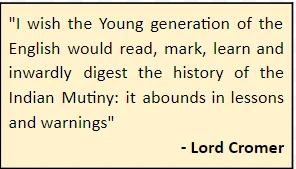The revolt of 1857 marked a watershed moment and a significant turning point in India’s history. It brought about substantial changes in the administration and policies of the British government. Prior to fully suppressing the revolt, the British Parliament passed the Act for the Better Government of India on August 2, 1858. This Act declared Queen Victoria as the sovereign of British India and established the position of a Secretary of State for India, who would be a member of the British cabinet.
Consequences
End of Company’s Rule: The British Crown assumed direct responsibility for governing India, putting an end to Company rule. The transfer of Indian governance to the sovereign of Great
- Britain was announced by Lord Canning during a durbar in Allahabad through the ‘Queen’s Proclamation’ issued on November 1, 1858. This proclamation also conferred upon the governor-general the additional title of ‘Viceroy’.
- Many of the assurances outlined in this proclamation appeared favourable to the Indian population.
- Some Form of Representation Established: The Revolt of 1857 underscored the critical need for improved communication between the governing authority and the populace. Sir Bartle Frere, in his influential Minute of 1860, advocated for the inclusion of Indian representatives in the Legislative Councils.
- This move aimed to familiarise the rulers with the sentiments and perspectives of the Indian population, thereby minimizing potential misunderstandings.
- Consequently, the Indian Councils Act of 1861 marked a modest initial step toward the establishment of representative institutions in India.
- This move aimed to familiarise the rulers with the sentiments and perspectives of the Indian population, thereby minimizing potential misunderstandings.
- Non-interference in Princely states: In the Queen’s proclamation of 1858, significant commitments were made by the British.
- They declared an end to territorial expansions and annexations in India, focusing instead on respecting the dignity and rights of native princes.
- Indian states were to acknowledge the paramountcy of the British Crown, operating as an integrated whole.
- They declared an end to territorial expansions and annexations in India, focusing instead on respecting the dignity and rights of native princes.
- Respect for Customs, Religion, and Way of life is promised: The proclamation assured the people of India the freedom to practice their religion without interference from British authorities.
- Moreover, it pledged equal and impartial protection under the law for all Indians, regardless of race or creed, and equal opportunities in government services.
- Old Indian rights, customs, and practices were also promised due consideration in the framing and administration of the law. This proclamation marked a pivotal moment in India’s history, outlining a shift towards a more inclusive and respectful approach by the British Crown.
- Reorganization of Military: In the aftermath of the 1857 revolt, the British undertook a comprehensive reorganization of the Army, guided by the principle of “division and counterpoise.”
- Restructuring the Military Composition: Recognizing the shift in Indian loyalty, the number of Indian soldiers was significantly reduced, while the count of European soldiers was amplified.
- The strategy of divide and rule was implemented, leading to the creation of separate units based on factors like caste, community, and region.
- Selective Recruitment of ‘Martial’ Races: Recruitment focused on individuals from the ‘martial’ races in Punjab, Nepal, and the north-western frontier, known for their allegiance to the British during the Revolt.
- Maintaining Military-Civilian Separation: Measures were taken to maintain a separation between the army and civilian population.
- The Army Amalgamation Scheme of 1861 involved transferring the Company’s European troops to the service of the Crown.
- Regular Rotation of European Troops: Additionally, European troops stationed in India underwent regular rotations, often referred to as the ‘linked-battalion’ scheme, to keep the force dynamic and effective.
- This overhaul reflected the British efforts to ensure greater control and stability in the post-revolt period.
- Revamping Indian Artillery: Following the 1857 revolt, significant changes were implemented within the Indian artillery units.
- Except for a handful of mountain batteries, most Indian artillery units were rendered inactive.
- Exclusive European Command: Higher-ranking positions within the army and artillery departments were exclusively reserved for Europeans.
- Surprisingly, until the early 1900s, no Indian was deemed worthy of receiving the king’s commission, and a newly arrived English recruit was regarded as superior to an Indian officer holding the viceroy’s commission.
- Restructuring the Military Composition: Recognizing the shift in Indian loyalty, the number of Indian soldiers was significantly reduced, while the count of European soldiers was amplified.
- End of the era of reform: The initial reformist spirit of a confident Victorian liberalism gradually waned, as many British liberals began to believe that reforming Indians was an insurmountable task.
- This shift, referred to as a ‘conservative brand of liberalism’ by Thomas Metcalf, garnered strong support from the conservative and aristocratic circles in England, advocating for complete non-interference in the traditional structure of Indian society. Consequently, the era of reforms came to a close.
- Emotional impact: There were negative and lasting emotional impacts of this revolt too.
- Racial bitterness was the most unfortunate consequence of the struggle. Depictions in publications like Punch portrayed Indians as subhuman, using derogatory imagery.
- Agents of imperialism viewed all Indians as untrustworthy and subjected them to insults and humiliation.
- Jawaharlal Nehru stated that combining imperialism and racialism leads to horror and degradation for all involved.
- Restructuring the Indian Government: The Indian government underwent significant restructuring based on the notion of a superior race, justifying this neo-imperialism with the idea of the “Whiteman’s burden” and England’s civilizing role in India.
This led to a widening gap between the ruling class and the Indian populace, resulting in periodic political conflicts, protests, and acts of violence.
- Increase In Autocratic Policies:
-
- The conservative backlash in England led to a more autocratic British rule in India, suppressing the aspirations of educated Indians to participate in governance.
- This approach ultimately backfired, fostering frustration among the educated Indian middle class and paving the way for the emergence of modern nationalism.
- Policy of divide and rule, initiated after the 1857 revolt, exacerbated social divisions.
- While territorial expansion halted, the British embarked on a systematic economic exploitation of India without restraint.
- Indian Civil Service Act of 1861, promoting equality under the Queen, in practice reserved higher services for the colonisers.
- Racial animosity and distrust between Indians and the English emerged as one of the revolt’s most damaging legacies.
- Racial Inferiority and Justification for Control: British media portrayed Indians as inferior beings necessitating control through force. Advocates of imperialism in India disparaged the entire Indian populace, subjecting them to insults and contempt.
- The entire structure of Indian governance was restructured around the notion of a superior race, rationalising the concept of the ‘White Man’s burden.’
- This deepened the divide between rulers and subjects, leading to political disputes, protests, and acts of violence in the years to come.
- The conservative backlash in England led to a more autocratic British rule in India, suppressing the aspirations of educated Indians to participate in governance.
Significance of the Revolt
The Revolt of 1857 holds immense significance as it served as a powerful expression of grievances by various segments of the population, even though it was characterized by violent upheaval. It brought to the forefront the realization that the British did not have complete control over their dominion in India.
- Foundations of Indian Nationalism: The Revolt of 1857, while not rooted in modern nationalism, united Indians and sowed the seeds of nationalism and anti-imperialism, marking the first major effort to break free from British rule and pave the way for future resistance movements.
- Collaborative Leadership and Mutual Respect among Hindu-Muslims: The Revolt of 1857 witnessed remarkable Hindu-Muslim unity, as both communities collaborated at all levels and respected each other’s sentiments.
- Bahadur Shah Zafar, a Muslim, was recognized as the emperor, and the successful regions enforced bans on cow slaughter, demonstrating harmonious coexistence.
- Leadership roles were diverse, with instances like Nana Saheb and Rani Laxmibai receiving support from individuals of different backgrounds.

- Exposing British Administrative Weaknesses: The Revolt of 1857 exposed significant flaws in the British East India Company’s administration and military, prompting the British to make necessary improvements.
- Revealing Grievances: The revolt brought to light the genuine grievances of both the Indian population and the sepoys (Indian soldiers).
- The Clash of Primitive and Advanced Weapons: It became evident that the primitive weapons possessed by the Indians were no match for the advanced arms of the British forces.
- The Impact of Brutalities on Indian Thinkers: The brutalities committed by both sides during the revolt deeply disturbed Indian intellectuals, leading them to conclude that violence was not the path to freedom.
- The Educated Middle Class’s Approach: The emerging educated middle class favoured a non-violent and orderly approach to achieving their goals.
- International Perspectives: The Revolt of 1857 garnered international attention, with figures like Benjamin Disraeli and Karl Marx questioning its nature.
- While Disraeli wondered if it was merely a military mutiny, Marx saw it as a broader national revolt.
- The event generated diverse interpretations, with Marxist historians emphasizing the struggle of soldier-peasant democratic forces against foreign and feudal rule, and others considering it a clash between civilization and barbarism.
- Revolt’s Influence on Local Traditions of Defiance Against British Rule: Despite these challenges, the revolt established local traditions of resistance against British rule, which would later prove valuable in the broader national struggle for freedom.
Views and Opinions
|
| Must Read | |
| Current Affairs | Editorial Analysis |
| Upsc Notes | Upsc Blogs |
| NCERT Notes | Free Main Answer Writing |
Conclusion
The Revolt of 1857 stands as a pivotal moment in India’s history, leaving an indelible mark on the course of the struggle for freedom. It unearthed the genuine grievances of both the populace and the sepoys, shedding light on the need for change in the administration and military apparatus of the British East India Company. While the revolt showcased the limitations of primitive weaponry against advanced arms, it also revealed the horrors of violence, prompting Indian intellectuals to seek alternative, non-violent means to attain their aspirations. Instead, a new challenge emerged for British Imperialism, stemming from a progressive India influenced by the ideals of John Stuart Mill and the nineteenth-century British liberals The emerging educated middle class advocated for an orderly approach to change. Ultimately, the revolt instilled local traditions of resistance, offering a foundation for the later, broader national movement for independence.
Sign up for the PWOnlyIAS Online Course by Physics Wallah and start your journey to IAS success today!
| Related Articles | |
| All About Local Self Government Under British India | The Revolt of 1857 |
| British Paramountcy in India | The Rise of Nationalism in India: Key Events and Movements |

 GS Foundation
GS Foundation Optional Course
Optional Course Combo Courses
Combo Courses Degree Program
Degree Program











